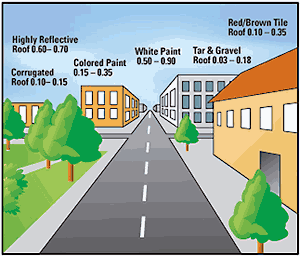
“Cool roofs are the roofs that can deliver high solar reflectance (the ability to reflect the visible, infrared and ultraviolet wavelengths of the sun, reducing heat transfer to the building) and high thermal emittance (the ability to radiate absorbed, or non-reflected solar energy). The benefits associated with cool roofs include reduced cooling energy load, reduced air pollution and greenhouse gas emission, and improved human health and comfort. Cool roofs may extend the roof service life and help mitigating the urban heat island effect.
Most of the roofs in the world (including over 90% of the roofs in the United States) are dark-colored. In the heat of the full sun, the surface of a black roof can increase in temperature as much as 50 °C (126 °F), reaching temperatures of 70 to 90 °C (158 to 194 °F). This heat increase can cause negative effects on cooling energy use and environments.
Cool roofs, on the other hand, offer both immediate and long-term benefits including:
– Reduced building heat-gain, as a white or reflective roof typically increases only 5–14 °C (10–25 °F) above ambient temperature during the day
– Savings of up to 15% the annual air-conditioning energy use of a single-story building
– Extended service life of roofs
– Improved energy efficiency of roofs, especially when there isn’t adequate insulation provided in the roof envelope
– Improved thermal comfort in buildings that do not have air conditioning
– Reduced air pollution and greenhouse gas emissions.”
Source: Wiki
Cool roofs can include the use of foil radiant barriers or reflective barriers that inhibit heat transfer by thermal radiation. See the Wiki article on Radiant Barriers. Reflective barriers/radiant barriers need airspace above them to work correctly, so wrapping a dome with reflective foil and covering directly with plaster won’t work. One option is heat reflective paint. Do any readers have first hand experience with heat reflective paint?
